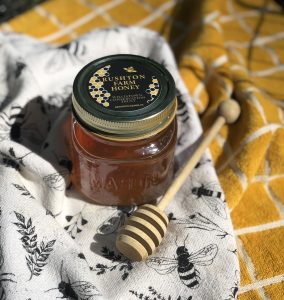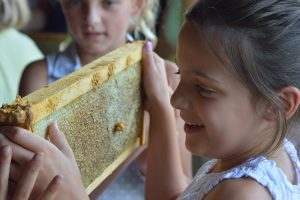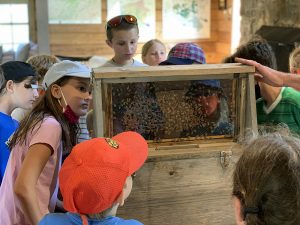The Latest Buzz at Rushton Farm
Photos by Blake Goll, Jennifer Mathes, Monica McQuailGet the lowdown on local bees & honey
 One sunny midsummer day in 2012 on Rushton Farm, the bees decided to swarm. Noah Guess, a certified apiarist—and the sustainable gardening manager teaching our group agro-ecology best practices that day—knew exactly what to do and quickly sprang into action. He smoothly and safely located the queen bee and removed the branch occupied by the swarm. This mesmerizing event lasted only a minute or two, before it was time to return to tending the row crops we were growing. Despite the brevity of Noah’s feat, it made a lasting impression on all of us who were there.
One sunny midsummer day in 2012 on Rushton Farm, the bees decided to swarm. Noah Guess, a certified apiarist—and the sustainable gardening manager teaching our group agro-ecology best practices that day—knew exactly what to do and quickly sprang into action. He smoothly and safely located the queen bee and removed the branch occupied by the swarm. This mesmerizing event lasted only a minute or two, before it was time to return to tending the row crops we were growing. Despite the brevity of Noah’s feat, it made a lasting impression on all of us who were there.
This memory was fondly recounted by Ben-jamin Reynard, a former intern at Willistown Conservation Trust’s Rushton Farm. Inspired by his experience with the bees, Ben made these vital pollinators the focus of his capstone project for the University of Pennsylvania’s Master in Environmental Science Program.
As he explains, “Thanks to the sustainable farming practices, focus on native plantings and abundant open space, we were able to identify 49 unique species of bees at Rushton Farm.” Ben went on to found Pollinator Patch, a nonprofit dedicated to restoring backyard habitat with the bees in mind.
Like Ben, many of us in southeastern Pennsylvania have likely experienced the hypnotic quality bees elicit, whether you’ve scrolled through viral bee content that’s taken over TikTok, read about bees perceiving time after scientists gave them jetlag, or perhaps picked up beekeeping as your pandemic hobby.
And it’s easy to understand why we’ve “caught the bug”—or rather, insect. Bees are responsible for our food crops, they maintain biodiversity by pollinating wild plants, and they produce sweet, delicious honey.
Honey’s Many Flavor Profiles
 In addition to having an astonishing sense of smell that allows them to seek out pollen and nectar from their preferred flowers, bees are the only insects to produce food eaten by humans: honey.
In addition to having an astonishing sense of smell that allows them to seek out pollen and nectar from their preferred flowers, bees are the only insects to produce food eaten by humans: honey.
Unlike store-bought honey that consists of a blend of honeys and tastes uniform, local honey is akin to a fine wine, offering unique flavor profiles with each batch. The nuance in flavor is a result of the food sources that exist within two to three miles of a bee’s hive, in addition to the temperature and weather of the season.
If, for example, there’s an abundance of one particular crop within a hive’s radius, the result is monofloral, or single crop, honey. Often, beekeepers will place their hives near target plants, such as blueberries or orange blossoms, to create pure, bold flavors. This honey is harvested immediately after the crop is finished blooming, to preserve the unique flavor associated with the target plants.
Meanwhile, polyfloral, or wildflower, honey is more common because it comes from a variety of nectar sources, such as a wildflower meadow. This makes for complex flavors and creates honey that’s unique each year. Typically, this type of honey contains a wider range of enzymes, minerals and nutrients, such as B vitamins, vitamin C, potassium, calcium and iron. It’s also credited with allergy relief from local pollens.
A taste of Chester County honey
 In the spring, local honey is milder in taste and lighter in color as a result of the bees collecting pollen from clover, black locust and dandelions. Come fall, the honey tastes bolder and turns darker in color thanks to pollen produced by goldenrod, rudbeckia and monarda. Tulip poplars are responsible for adding a reddish tint to the honey, and an abundance of locust nectar can help the honeybee produce 30 pounds of honey in just one week.
In the spring, local honey is milder in taste and lighter in color as a result of the bees collecting pollen from clover, black locust and dandelions. Come fall, the honey tastes bolder and turns darker in color thanks to pollen produced by goldenrod, rudbeckia and monarda. Tulip poplars are responsible for adding a reddish tint to the honey, and an abundance of locust nectar can help the honeybee produce 30 pounds of honey in just one week.
Recently local beekeepers have observed a new honey produced by their colonies in the fall: honeydew honey. According to the Philadelphia Beekeepers Guild, honey bees have been feeding on honeydew—the sugary substance excreted by the spotted lantern fly, not the melon—to create this type of honey commonly found in other parts of the world. It’s dark in color with an earthy, smoky flavor that isn’t quite as sweet.
The honeydew honey’s unique taste is most likely a result of the lanternfly’s preferred food source: tree of heaven. Apiarists believe that the spotted lanternfly honeydew serves as an excellent food source for the bees as they prepare to overwinter.
THE FUTURE OF THE BEES
 Of course, the best way to produce quality honey is to ensure its makers survive. Sadly, annual surveys indicate that honey bees are continuing to die at alarmingly high rates.
Of course, the best way to produce quality honey is to ensure its makers survive. Sadly, annual surveys indicate that honey bees are continuing to die at alarmingly high rates.
Back at Rushton Farm, Director of Community Farm Program Fred de Long is preparing to facilitate a second bee population study with the assistance of another student.
Fred recommends avoiding use of pesticides and herbicides, which are the biggest threat to bee colonies. Additionally, Rushton Farm Field Manager and apiarist Noah Guess suggests removing row covers at optimal times to allow pollinators access to the plants, and to maintain mulching between rows of crops or in your garden so bees and other important pollinators can safely overwinter.
Currently the honey bees are busy gathering pollen and nectar from late blooms and apple orchards to prepare their colonies for the upcoming winter season, which, sadly, many will not survive. When the mighty survivors do ultimately emerge from their colonies next spring, they’ll begin pollinating early crops like almonds, apples and cherries.
And soon enough, you can begin your honey-tasting journey, perhaps with a greater appreciation for the busy bees that make it all possible.
Willistown Conservation Trust supports the unique combination of land conservation, sustainable farming, bird conservation, habitat restoration and watershed protection, in addition to providing educational programming and outreach events at the Rushton Conservation Center. Visit WCTrust.org for more information.
HONEY RECIPES
HALLOUMI WITH HONEY & ALMONDS
8 oz. halloumi cheese, sliced ½” thick
1–2 tsp. olive oil (if needed)
2 Tb. local honey
Flaky sea salt
Optional toppings: 2 Tb. almonds, pistachios or pumpkin seeds, toasted and finely chopped, or 1 Tb. sesame seeds, toasted
Heat a well-seasoned cast iron or nonstick skillet over medium-high heat.
Place a few slices of the cheese in the pan and sear on one side until golden brown, about 3–5 minutes. Turn over the slices and repeat on the other side.
Remove the slices and place on a small platter. Repeat until all the slices have been browned.
Drizzle the cheese with the honey and sprinkle with your choice of nuts or seeds and flaky salt. Best served warm, but also good at room temp. Use hands, toothpicks or small forks to eat.
BEE’S KNEES
2 oz. gin
¾ oz. lemon juice, freshly squeezed
½ oz. honey syrup, made with your favorite local honey
Garnish: lemon twist
Make a thick honey syrup by heating on a stovetop 2 parts honey to 1 part water. Consider adding rosemary, thyme or mint for more flavor.
Add the gin, lemon juice and honey syrup into a shaker with ice. Shake until well chilled.
Strain into a chilled cocktail glass.
Garnish with a lemon twist.
Optional: Replace gin with sparkling water for a delicious mocktail.
